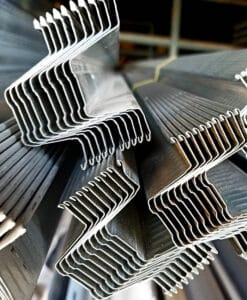In the bustling realm of building projects, making informed selections regarding structural elements is key to the longevity and functionality of edifices. As you progress in planning and execution, grasping the subtle distinctions between c and z purlin becomes essential for informed decision-making that resonates with your project’s objectives. This knowledge allows you to optimize the structural integrity and efficiency of your construction projects, ensuring they meet both functional and aesthetic standards.
Z vs C Purlin: Structural Differences
Gripping the structural components that fortify our edifices is vital in building construction. Purlins, the backbone for roof and wall panels, provide the necessary span across the principal structural frame. The shift to metal purlins, especially C and Z types crafted from cold-formed steel, marks a significant leap in fortifying the integrity and robustness of modern frameworks. Understanding these differences helps ensure the right choice for your specific building needs.
Also Read: Mastering Purlin Roof Framing: Your Step-by-Step Guide
Shape and Design: Analyzing Z and C Purlins
Breaking down the structural variances between Z and C purlins unveils:
- Z purlins are distinguished by their Z-shaped profile, which provides flexibility in overlapping and is beneficial for long-span structures. This design supports a continuous span across multiple supports, heightening the structural solidity and stability of the build.
- C purlins feature a C-shaped profile. This straightforward design is ideal for wall and floor support. Although they lack the overlapping flexibility of Z purlins, their installation simplicity and efficacy in standard construction scenarios make them a valuable option.
Material and Manufacturing of Z and C Purlins

When considering materials and manufacturing processes, key points include:
- Both purlin types are primarily crafted from cold-formed steel, offering numerous advantages in construction.
- Cold-forming steel enhances the purlins' strength and stiffness, which is crucial for supporting roofing and wall loads, including external pressures like snow or wind.
Practical Applications: Z Purlin vs C Purlin
The decision between Z purlins and C purlins is critical in construction, particularly concerning structural integrity.
C purlins, with their C-shaped cross-section, offer a direct design with a vertical back and two horizontal flanges. This configuration provides practical benefits in construction, primarily for wall and floor support. Their shape allows easy attachment of wall panels or roofing sheets, rendering them versatile for diverse applications.
Z purlins feature a Z-shaped cross-section, granting a unique edge over C-shaped counterparts. This design includes a central web with flanges at opposing angles, delivering superior strength and allowing for overlapping, making Z purlins suitable for large-area projects. They mainly support roof and wall joists, ensuring roofing material stays secure. The adaptability of Z purlins stems from their adjustable sizes, making them apt for a broad range of applications.
Comparing Z and C Purlins: Installation and Efficiency
In construction, especially for commercial, industrial, and agricultural projects, selecting between C and Z purlins is vital. Each serves a distinct purpose based on the project's design and environmental challenges.
C purlins, with their C-shaped profile, are typically used where wall and floor support are essential. This makes them perfect for structural frameworks of walls and floor joists in buildings. Their versatility enables them to be used for various construction needs, from door mounting to roof clipping.
Z purlins, identified by their Z-shaped profile, primarily support roof and wall joists. This design is particularly advantageous in agricultural and industrial buildings with crucial roof and wall support. Z purlins' unique shape allows for overlapping, which benefits metal buildings designed for longer spans. This overlapping not only enhances structural integrity but also promotes efficient material use. Z purlins are often chosen for their flexibility and lightweight properties, which are suitable for a wide range of sizes and applications.
Conclusion: The Informed Choice for Your Construction
The decision to use C or Z purlins depends on several factors, including environmental conditions and specific design requirements. Understanding these differences is crucial for construction professionals, enabling informed decisions that optimize construction efficiency and cost-effectiveness.
As you conclude your exploration of Z purlin vs C purlin, the choice between these two emerges as integral to any construction project's success. The insights guide you towards informed decisions catering to your project's structural needs. Whether it is the flexibility and spanning capability of Z purlins for roofing needs or the straightforward, robust support of C purlins for walls and floors, your choices shape the future of your constructions. Each decision, especially regarding structural elements, paves the path for enduring projects. For Steel product manufacturers in India, choosing wisely ensures your constructions stand the test of time with the right purlin choices.

